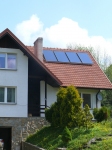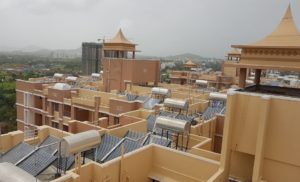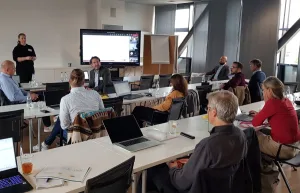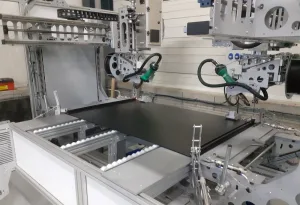

Poland: various commercial Grant Programmes
 By the end of 2010, the total surface area of solar collectors in Poland reached 655,000 m2. Newly installed collector area amounted to 146,000 m2, roughly 2,000 m2 more than in 2009. Over the next years, the number of new solar thermal installations is thought to increase significantly because of various grants at the national and local level: The local incentive programme in Szczawnica in southern Poland has already helped in setting up more than 1,500 collectors in households (see photo).
By the end of 2010, the total surface area of solar collectors in Poland reached 655,000 m2. Newly installed collector area amounted to 146,000 m2, roughly 2,000 m2 more than in 2009. Over the next years, the number of new solar thermal installations is thought to increase significantly because of various grants at the national and local level: The local incentive programme in Szczawnica in southern Poland has already helped in setting up more than 1,500 collectors in households (see photo).
Photo: szczawnica.pl
According to the aims the Polish government set forth in its National Renewable Energy Plan (NREAP), the total surface of collectors in Poland is going to reach 15 million m2 by 2020. Provided that results hold up to expectations, Poland would become the fifth largest solar thermal market in Europe behind Italy, Germany, France and Spain within the next 10 years.
The growth of Poland’s solar thermal market is driven by various grants available at the national and local level. The money to subsidise the solar installation comes from both the EU and the Polish government. Depending on the financing source, the grants are available mainly to households, SME’s and/or public entities.
Poland’s main incentive scheme for households is a programme managed by the National Fund for Environmental Protection and Water Management (NFOŚiGW).Since its start in September 2010, subsidies have been granted to 8,166 households and the Fund has already spent EUR 6.25 million of its 75-million budget. Average solar installation costs of submitted applications amount to EUR 3,500.
NFOŚiGW also runs incentive schemes dedicated mainly to local public entities, such as local government offices or public hospitals. To further boost energy efficiency, the subsidies are often used to install larger solar installations as part of modernising a building complex.
The regional branch offices of NFOŚiGW have additional incentive schemes for small and medium enterprises (SMEs) and the public sector, providing investors with low-interest credit lines. The Fund’s preferential credit line in Malopolska province, southern Poland, helped to finance the highest number of solar thermal projects at the regional level. For example, in Szczawnica alone, the investment contributed to the installation of more than 1,500 collectors in households. In most cases, the provincial NFOŚiGW will repay a significant share of the credits after successfully incorporating co-financed investments.
Apart from the Fund for Environmental Protection, an important source of financing solar installations is the EU, which offers beneficiaries subsidies of even up to 85% of the installation costs. EU funds are available at both the national and local level. However, the Infrastructure and Environment Operational Programme (IEOP) – the main EU fund for renewable energy in Poland managed by the Ministry of Economy – has so far mostly supported green electricity production. The solar thermal market has enjoyed its growth primarily thanks to the EU Local Operational Programmes present in each of the 17 Polish provinces. Although most of the funds in the EU’s 2007-2013 budget have been exhausted by now, the new EU budget should keep up resource-intensive energy and environmental projects in Poland.
The new incentive scheme introduced in 2011 is a EUR 150 million preferential credit line for SME solar thermal installations, financed by the European Bank for Reconstruction and Development under the Polish Sustainable Energy Efficiency Financing Facility (PolSEFF). Administered through a few of Poland’s commercial banks, it aims to increase energy efficiency in Polish companies either by saving energy or supplying it from renewable sources.
The aforementioned mechanisms should be sufficient to guarantee a dynamic development of the Polish solar thermal market in the coming years and strengthen the domestic solar industry. The biggest local producers – Hewalex, Watt and Sunex – not only dominate Poland’s market, but export up to 50% of their stocks, mainly to EU countries. The quality of Polish collectors is usually confirmed by Solar Keymark certificates. According to the Polish Institute for Renewable Energy, Poland’s solar thermal industry already employs around 4,300 people. By 2020, this number could reach more than 40,000.
More information:
http://www.nfosigw.gov.pl/en/
http://www.polseff.org/
Infrastructure and Environment Operational Programme (IEOP): http://www.pois.gov.pl/english/Strony/Introduction.aspx
Piotr Pajak is one of the founders and the responsible editor of the Polish web portal http://www.Heliosfera.pl, which focuses on the solar thermal sector, and http://www.gramwzielone.pl, which gives media coverage of the green energy industries in Poland and acts as a consultancy for companies interested in entering Poland’s renewable markets.


